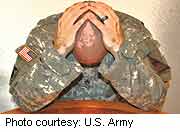- Skip Storing This Everyday Product in the Fridge Door
- Green Tea + B3 Pairing May Boost Brain Health
- Navigating Your Midlife Crisis: Embracing New Possibilities
- City Raccoons Showing Signs of Domestication
- Mapping the Exposome: Science Broadens Focus to Environmental Disease Triggers
- One Week Less on Social Media Linked to Better Mental Health
- Your Brain Changes in Stages as You Age, Study Finds
- Some Suicide Victims Show No Typical Warning Signs, Study Finds
- ByHeart Formula Faces Lawsuits After Babies Sickened With Botulism
- Switch to Vegan Diet Could Cut Your Greenhouse Gas Emissions in Half
Study: Similar Outcomes From Combat Head Injuries, Regardless of Cause


Brain injuries in U.S. military personnel deployed to Iraq and Afghanistan have similar outcomes whether the cause was a blast or another trauma, a new study reveals.
The researchers also found that nearly 80 percent of all active military personnel who suffered a concussion — regardless of cause — developed moderate to severe overall disability within a year after the injury.
An estimated 20 percent of U.S. forces in Iraq and Afghanistan suffered a head injury, and concussion occurred in about 83 percent of those cases, according to the new research, which was published June 16 in the journal JAMA Neurology.
The researchers assessed 178 military personnel six to 12 months after they suffered a concussion while serving in Iraq or Afghanistan: 53 were injured in a blast, and 29 were injured by other causes.
The study also included two “control” groups of 27 military personnel who were exposed to blasts but suffered no brain injuries, and 69 who had no blast exposure but required medical treatment for injuries other than brain trauma.
Rates of overall disability were nearly the same for patients with both blast- and nonblast-related concussion, 77 percent and 79 percent, respectively. The two groups also had no differences in headache severity, depression, post-traumatic stress disorder (PTSD), and scores on mental skills tests, the investigators found.
Both blast- and nonblast-concussion patients had worse overall disability than those in the control groups. Rates of moderate-to-severe disability were 59 percent in the blast-without-head-injury group and 41 percent in the no blast/no head injury group.
“For our patients with blast-related concussions, I want to emphasize that the explosion was always in combination with another event, such as a motor vehicle crash, a fall or an object striking the head,” study senior author Dr. David Brody, an associate professor of neurology at Washington University School of Medicine in St. Louis, said in a university news release.
“It’s important that we’re mostly studying the combination of blast plus impact, compared to impact alone. Blast injury alone — without a secondary impact — appears to be extraordinarily rare,” he explained.
“This study and others make us a bit skeptical of the notion that the long-term effects of blast injury to the brain are somehow unique,” Brody said. “We still think the physics of how a blast interacts with the brain is quite different from other kinds of brain trauma. But we have yet to find the consequences of that — if there are any — for patients.”
The researchers also found that all military personnel who suffered concussion had much higher rates of disability than civilians with concussion, which suggests that active military duty is a factor.
“Poor outcomes appear to be associated most strongly with having a traumatic brain injury while on active military duty,” Brody said. “It’s also possible these brain injuries in military personnel that resulted in medical evacuation were more severe than we typically see in a civilian population. After a sports-related concussion, for example, many people make a good recovery over several weeks.”
More information
The U.S. National Library of Medicine has more about concussion.
Source: HealthDay
Copyright © 2025 HealthDay. All rights reserved.










